Black Sea, Caspian Sea
At Istanbul innumerable "Otobusleri" ferries and also hi-speed catamarans are crossing the Bosporus and the bays beneath the classic Suleimanye Mosque, the Sultan's palace, the historic Hagia Sophia and the fantastic Blue Mosque. There the voyage towards the Black Sea begins, passing the Bosporus, thanks to international convention open to every ship of every nation. Even during the decades of the Cold War some mysterious Soviet warship could have been watched there and was registered by western intelligence services. Now, cruise ships are passing the Bosporus.
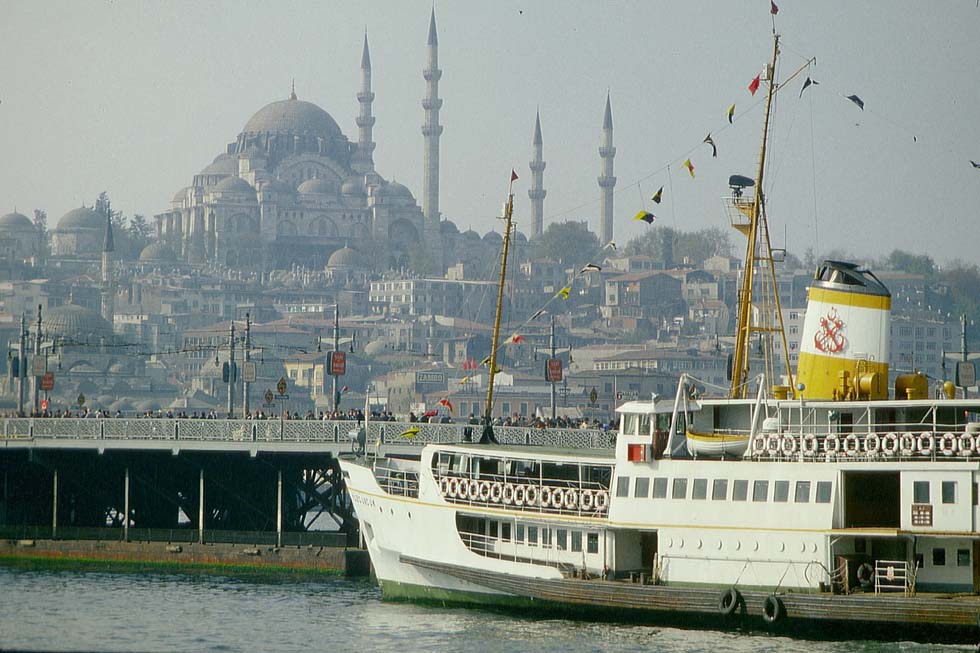
Istanbul, 1977 (WS)
Black Sea
The Black Sea has once received its name because of the prevailing dim atmosphere compared with that of the Aegean. Nevertheless its coasts come up with an almost subtropical climate during the summer months. In the southwest it is connected by the Bosporus, the Marmara Sea and the Dardanelles with the Mediterranean. From 1853 to 1856 the Crimean Peninsula has become the theatre of a bloody war, when Tsar Nicholas I pretended having to protect the Christians of the Danube Principalities under Turkish rule. After a Russian invasion, England and France declared war to prevent Russian dominance over the Balkans. The war ended with the surrender of the besieged sea-fortification of Sevastopol to the allied naval forces. During World War I the Osman Empire under Mohammed V fought at the side of the Germans, the genocide among the Armenians and the defeat being the tragic results. After WWI, the Western Powers divided up the Osman Empire, once one of the greatest and mightiest powers in history. With the Treaty of Sevres (1920) it lost all territories beyond the Anatolian mainland. Constantinople, now Istanbul, remained the only section on European soil, "neutralized" however. When Kemal Ataturk came to power, he started a national uprising against foreign occupation troops. In the following Treaty of Lausanne (1923) a convention was arranged for an exchange of ethnic minorities. That meant a great tragedy for some hundred thousands of expelled people, particularly for the Greek having settled there for centuries. After WWII, with Nato, Turkey became definitely a country of the western world. And with the collapse of the Soviet Union in 1991, Ukraine and Georgia emerged as liberated republics on the shores of the Black Sea.
Early Steamers
"The deck is crowded with people wearing picturesque costumes, people with proud and noble faces, showing deep affliction and despair...". That is an impression of a voyage aboard the Austrian Lloyd steamer "Espero" from Varna, Bulgaria, to Constantinople in 1883, written down by Edmond About, one of the honorary guests participating in the official inauguration of the Orient-Express, which had brought them from Paris to Romania, where they took a small steam boat to cross the Danube and then another train to catch the "Espero", crowded with Turkish families expelled after the first Balkan War.
Steamer services to the Bosporus started in 1837 when the French government opened a route Marseilles - Constantinople, tightly followed by Oestereichischer Lloyd. Hendschel's Telegraph timetable e.g. of 1856 showed Lloyd services Trieste - Piraeus - Smirna (Izmir) - Dardanelles - Constantinople, Constantinople - Burgas - Varna and Constantinople - Trabzon. At Galati the Lloyd connected with Danube steamers.
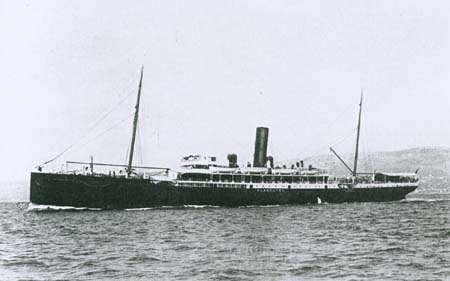
"Cleopatra", Oesterreichischer Lloyd, Black Sea mail route (Technisches Museum, Vienna)
|
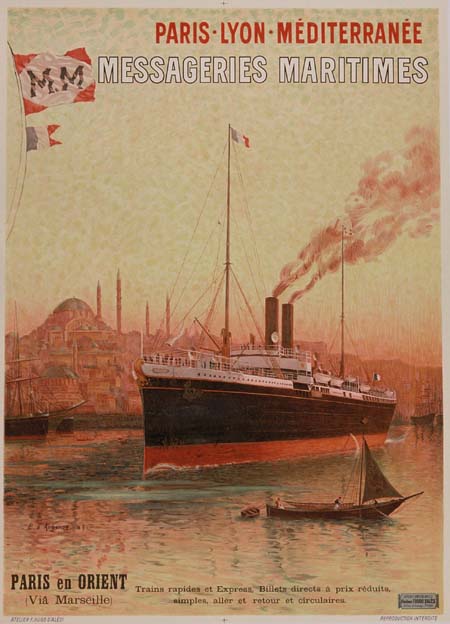
Messageries Maritimes (coll. Juergen Klein)
|
In 1851 the French government steamers were replaced by the company which from 1871 became famous as Messageries Maritimes. In 1844 also the P&O had opened an early branch line to Greece and Constantinople, abandoned when the ships were used for the Crimean War. In the 19th century Navigazione Generale Italiana, the later Societa 'Italiana', served Constantinople. Towards the end of the 19th century the Panhellenic Steam Navigation Co. connected Trabzon on the Black Sea, where many Greeks were living. Romania became served by Oesterreichischer Lloyd and by Serviciul Maritim Rouman, the state line of Romania, departing at Constanza. That Romanian harbour got a British-built railway in 1860, but only with completion of the Danube bridge in 1895 the Orient-Express from Paris and the Ostend-Vienna Express could connect there with Romanian express steamers for Alexandria, until WWI only. Under the designation Service Maritime Roumaine a route with the "Imperial Trajan" (1906/ 3,152 gt) and "Dacia" between Constanza and Alexandria was advertised. From 1933 the 'Fulgur Regele Carol I', a CIWL 'Pullman' train, ran from Bucharest to the sea resorts with a portion detached for Constanza Port on the days of a ship's departure.
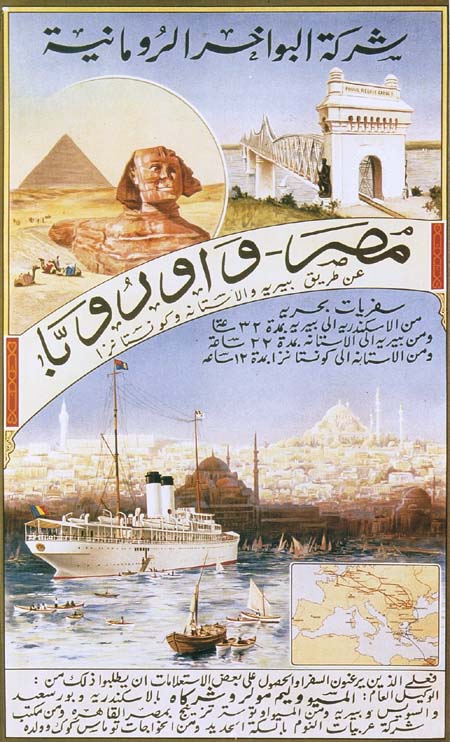
"Imparatul Trajan", Serviciul Maritim Rouman, c.1910 (coll. Juergen Klein)
|
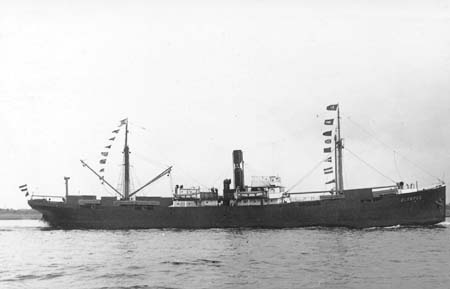
"Olympos", Deutsche Levante-Linie (old card, coll. WS)
|
At the end of the 19th century, also Odessa was served by Oesterreichischer Lloyd, Messageries Maritimes, Navigazione Generale Italiana, and Papayanni of Liverpool. After Germany was awarded the contract to build the Anatolian railway, Carl Laeisz and Adolph Woermann founded in 1889 the Deutsche Levante-Linie, first for cargo, mainly for transportation of material for the politically supported railway projects (for the company's North Atlantic services see the main chapter North Atlantic/ Mediterranean). In 1898 the Deutsche Levante-Linie introduced the "Pera" (2,500 gt, ex "Porto Alegre") and then the "Stambul" and "Therapia" for 1st-class passengers and mail on a Hamburg - Maghreb - Constantinople - Odessa route. In 1906 Norddeutscher Lloyd joined the stagnating business, introducing in 1908 the old mail steamers "Preussen", "Bayern" and "Sachsen" on a Marseilles - Odessa - Batumi route, closed down in 1913 on account of the Balkan Wars.
Russian Expansion
Russia under the Tsar was always eager to get access to the "warm" seas. In 1850 a steamship line to Bombay was started from the Ukrainian harbour Odessa. At least after the Crimean war, the French service to Constantinople connected with a branch line to Kamiesh on the Crimean peninsula. The war urged the Tsar to link Odessa by a railway, in 1874 united with the Russian steamship company, officially the Russische Dampfschiff- & Handelsgesellschaft. After the Russian-Turkish war of 1877/78, the steamship line became a separate company. Until World War I services to Constantinople and Alexandria were published under the title Russian Steam Navigation Co. In 1880 the Tsar's Volunteer Fleet took up services from Odessa to Vladivostok for a quite different strategic purpose. In 1901 a shipping route from Odessa to the Persian Gulf was opened, after the intention of a Russian railway from Trabzon on the Black Sea to Iskenderun on the Mediterranean or to a harbor on the Persian Gulf had failed.
Batoumi in the east was connected during decades before WWI by the Russian Steam Navigation Co. and also by foreign lines, including the Cie de Navigation Paquet. During these years Russia's wealthy aristocracy could travel by an exclusive Black Sea Express from St. Petersburg to Novorossisk and take there the connecting steamer to the spas on the east coast of the Black Sea. These coastal services and the Sea of Azov lines were run by the Russian SN Co.
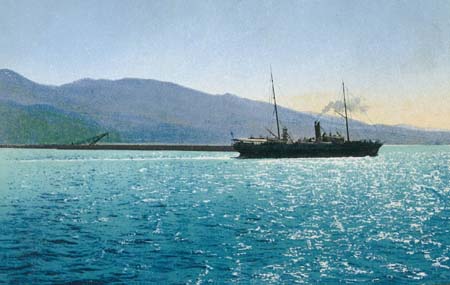
Russian passenger steamer "Kavkaz", leaving Novorossisk, before WWI (old card, coll. WS)
|
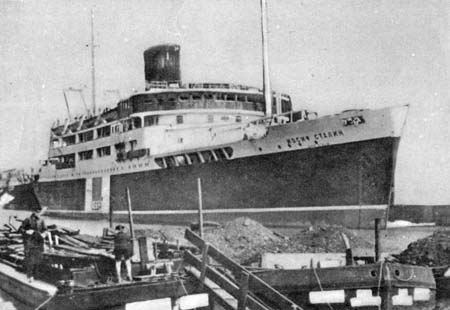
"Josif Stalin", Sovtorgflot (coll. HSch)
|
Between WWI and WWII
During World War I Russia and Romania fought on the side of the Allies. After the coup of 1917, Russia became the Soviet Union and in 1925 Sovtorgflot was organized out of the Russian Mercantile Fleet. In the 30s the timetable showed the routes Odessa - Novorossiysk - Poti - Batumi and also Odessa - Istanbul - Piraeus - Jaffa - Port Said. The proudest ship, a 7,745-ton turbine steamer, built in 1939 in the Netherlands, of course sported the name of the tyrant, "Josif Stalin". Her sister was the "Vyatchislav Molotov".
From 1928 Typaldos of Greece was listed with a route Constanza - Istanbul - Piraeus - Chania - Alexandria with the "Ioniou". Batumi was connected with Trieste by the Lloyd Triestino, in 1937 replaced by a service of Adriatica. Constanza continued to be connected with Alexandria by Serviciul Maritim Roman. In 1937 that Romanian state line introduced the 6,672-ton motor-ships "Transylvania" and "Besarabia" on the Alexandria route.
During WWII German troops conquered the northern shores of the Black Sea. In Odessa the partisans, living in catacombs beneath the town, fought the Germans, while Hitler's holocaust raged. The proud ship "Josef Stalin" was captured by the German navy and thus the thousands of soldiers aboard were saved from being killed by a torpedo. Among uncompleted ships, the historians Bock mentioned (with reference to 'Schiffbau', 1941) the projects "Proletariy" and "Trud", but about the purpose nothing is known. From spring 1944 the shores of Russia and Ukraine were once again in the hands of the Soviet army. The way to Batumi was shortened in 1945 by a direct rail link via Sochi.
USSR after WWII
After WWII, the Soviet Union got in 1946 the former "Patria" of Hapag, world' first diesel-electric ship, which had served the British Ministry of Transport. She became the 17,870-ton "Rossiya" on routes departing from Odessa and she survived until 1985. The "Vyatchislav Molotov" was transferred to Leningrad, after the end of the Stalin cult renamed "Baltika". A postcard of the late 50s showed the "Petr Velikiy", employed in the Black Sea. The Soviet handbook "Spravochnik Passazhira" listed e.g. in 1971 services Odessa - Yalta - Batumi still with the "Rossiya", the "Abhkaziya" (ex "Marienburg", 1939/57, 6,807 gt), the "Graziya" (ex "Sovieski", in 1939 built in Poland), the 17,033-ton "Admiral Nakhimov" (ex "Berlin" of NDL, repaired 1951-57), the 9,829-ton "Pobeda" (ex "Magdalena", "Iberia" of Hapag, 1947-77 used mainly on Black Sea routes), the 6,406-ton "Ukraina" (built in 1938 at Copenhagen), the "Petr Velikiy" and other vessels, all of them described as motor-ships. The "Admiral Nakhimov", with her white paint and two short funnels an elegant ship, collided in 1986 with a freighter. It meant her end and 398 among her passengers died. Among the newbuilds listed were ships of the Leningrad-built Tallinn class, the Wismar-built Mikhail Kalinin class and even the 20,064-ton "Ivan Franko" and "Shota Rustaveli" of the 'Five Poets' class, true ocean liners - see chapter North Atlantic. Motorcar transport was offered with the "Moskvich", "Zaporozhets", "Zhiguli", "Pobeda", "Volga", and ZIL".
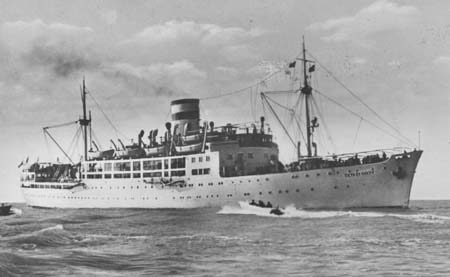
"Petr Velikiy" (card of 1957, coll. WS)
|
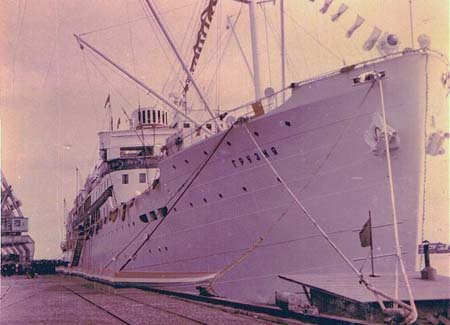
"Graziya", ex "Soviesky" of 1939, Helsinki 1962 (Kanton 68, via Wikimedia)
|
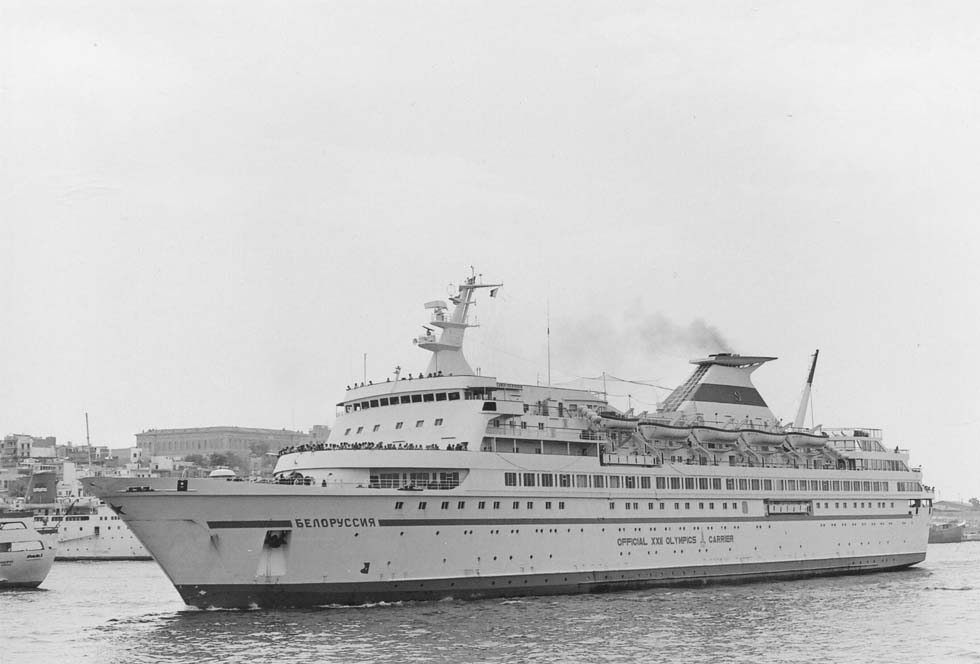
"Belorussiya", Piraeus 1980 (WS)
The international services of the Black Sea Shipping Co. were concealed by the Spravochnik, nevertheless they existed. After WWII the Soviets repositioned the "Cooperatzia", built in 1929 already as a motor-ship for London services, to the Black Sea for an Odessa - Haifa route. The Soviets provided services temporarily to Marseilles with the "Litva" of the Mikhail Kalinin class, to Alexandria with her sisters and to Barcelona with the 16,631-ton "Belorussiya" of the series built in Finland. Also Albania of ultra-communist dictator Enver Hoxha was not forgotten, while Romanian passenger lines have disappeared from international timetables.
The Shipping Guide mentioned also tours provided by the Soviet Danube Shipping Co. with river vessels connecting at Izmail with the "Aywasovskiy". Combined Black Sea and Dnepr services were later offered with river boats built also for deep-sea routes. Cook's Timetable listed until 1990 also services Odessa - Algiers - Tripoli with the Polish-built 9,800-ton "Lev Tolstoy", to Alexandria with the "Adzhariya", "Bashkiriya" and "Armeniya", rather similar to the Mikhail Kalinin class, and to Barcelona with the with the Polish-built 13,251-ton "Dimitriy Shostakovich".
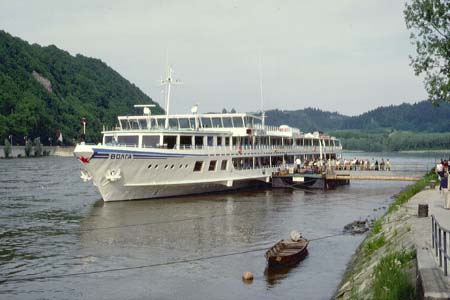
"Volga", Danube ship at Passau, 1985 (WS)
|
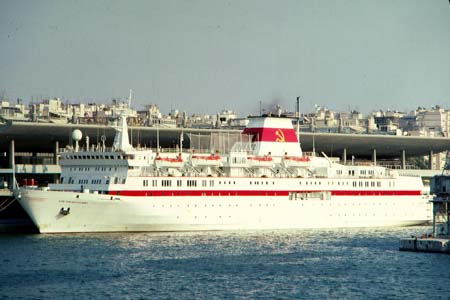
"Dimitriy Shostakovich", Piraeus 1991 (WS)
|
Black Sea Liberation
Years after the end of the Soviet Union, Blasco Ukraina, then Ukr Ferry, owned by the state of Ukraine, maintained the Odessa - Istanbul route and offered a service from Il'yichevsk to Poti and Batumi in Georgia with the "Greifswald". She is one of the vessels originally built for Mukran - Klaipeda rail ferry services in the Baltic (see chapter Passenger Train ferries/ Other Connections). There appeared other operators, too. Sari opened a route Sochi - Trabzon. Cook listed the service Istanbul - Yalta - Novorossiysk and Istanbul - Yevpatoria by the Bumerang Shipping Co. of Istanbul. ShipPax mentioned a passenger service Novorossiysk - Istanbul by the cargo line Novorossiysk Shipping Co. with the "Mariya Yermolova", one of the four 3,941-ton motor-ships built in Yugoslavia. The traditional coastal services from Istanbul to Trabzon and Rize by Turkish Maritime Lines have disappeared from the timetable. Instead, cruise shipping developed.
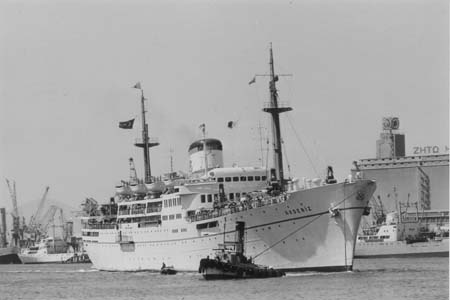
"Akdeniz", Turkish Maritime Lines, Piraeus 1973 (WS)
|
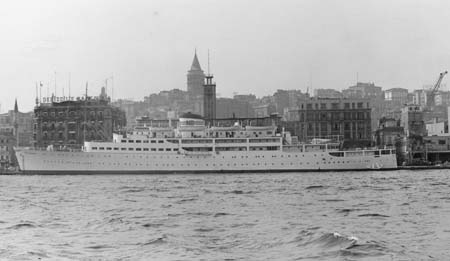
"Transilvania" of NR, Istanbul 1973 (WS)
|
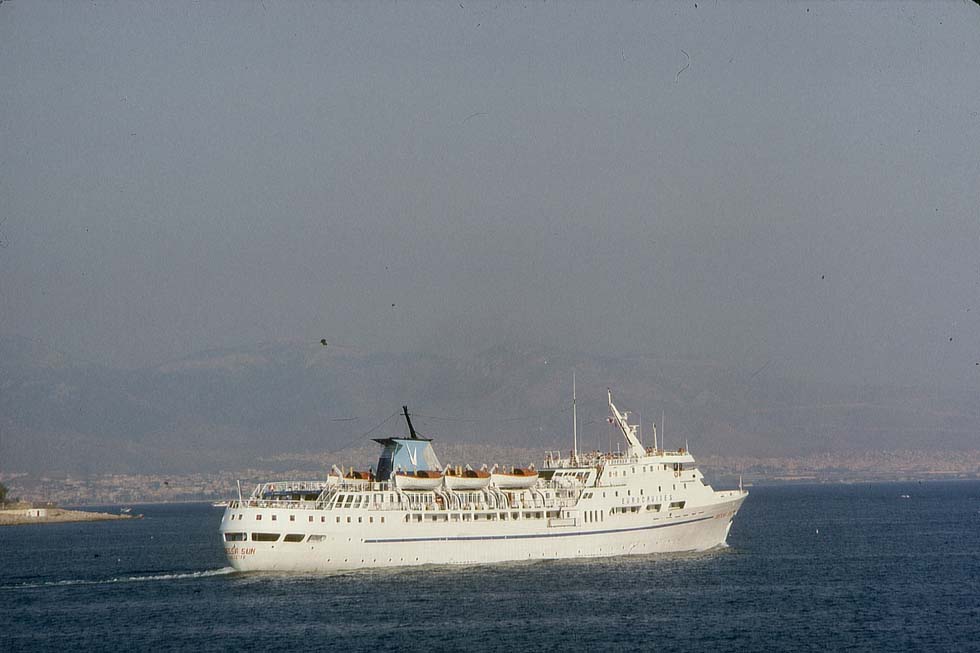
"Odessa Sun", Eurocruises ex Odessa Cruises, Piraeus 1993 (WS)
Between Ukraine and Russia there are the local ferries of the Kerch Strait. A flashpoint on the shores of the Black Sea was the Crimean peninsula. Though populated mainly by Russians, it had been incorporated into the Ukrainian Soviet republic in 1954. After the end of the Soviet Union in 1992, Russia kept its traditional Crimean naval base Sevastopol only by way of lease. In 2010 the treaty was prolonged, after Ukraine gave up NATO ambitions.
On the eastern shore of the Black Sea the port of Poti made headlines when it was occupied by Russian military forces in 2008 in course of the South Ossetia war between Georgia and Russia. The war led to autonomy of the Russian-populated northern coastal region Abkhasia and to interruption of rail services from Russia. In summer 2009 Georgian forces captivated tankers bound for Abkhasia.
Caspian Sea
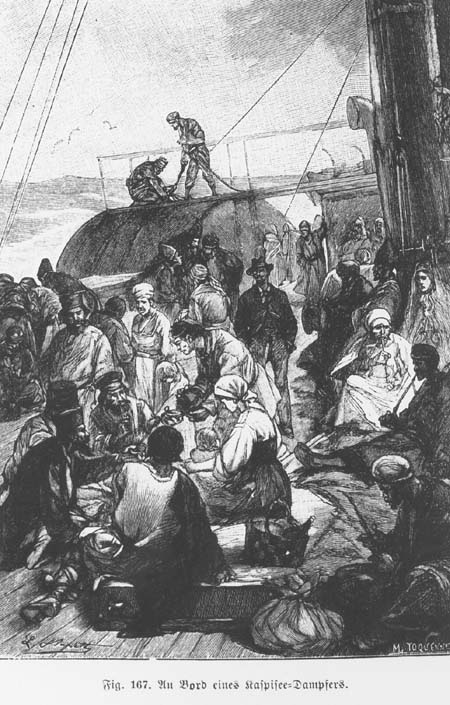 Caspian Sea steamer (Schweiger-Lerchenfeld)
Caspian Sea steamer (Schweiger-Lerchenfeld)
Towards the end of the 19th century, the timetable showed the Russian Steam Navigation Co. connecting at Batoum (Batumi) with trains to Tiflis and further on to Baku by the Trans Caucasus railway, completed already in 1882. Thus the way from the Russian capital to the Caspian Sea necessitated crossing the Black Sea until in 1900 the direct railway to Baku was completed. There the Russian Steam Navigation had its departure for Krasnovodsk on the eastern shore of the Caspian Sea, where in 1896 a new harbour was opened. Building the connecting Trans-Caspian railway had started in 1880 at Mikhailovsk, then the harbour was relocated to Usun Ada and finally to Krasnovodsk. Also a shipping line from Petrovsk to Krasnovodsk appeared on the maps. One of the few foreign travelers who could go there even under Stalin's rule, Bosworth Goldman, mentioned in "Red Road through Asia" (published in 1934) an old-fashioned clean paddle steamer, what means a ship of the Tsar's epoch, leaving Krasnovodsk quay.
Cook's timetable e.g. of 1897 listed a route Petrovsk (Makhachkala) - Baku - Usun Ada and among the monthly services one from Baku to Enzeli in Persia (Iran). Also the Bradshaw of 1914 showed the Baku - Enzeli steamer route with the remark: "Teheran about 200 miles from Reshd" (the city close to Enzeli). Timetables of the mid-30s listed services from Astrakhan in the north to Baku and also a line from Baku to Enzeli and further on to Bandar-i-Gaz. This port is situated on the Trans-Iranian railway, completed in 1938 between the Persian Gulf and Bandar Shah (now Bandar-e Torkman) on the Caspian Sea. It achieved a tremendous strategic importance during World War II, when Allied ships unloaded the supplies for the Soviet Union at Bandar Shahpur, Khorramshahr and at Tanuma on the Shat-Al Arab for being transported by rail to the Caspian Sea.
Published megalomaniac plans of linking the Caspian with the Aral Sea and Siberia by canals remained a utopia. Considerations of a railway tunnel beneath the Caspian Sea from Baku to Krasnovodsk were equally unrealistic.
After WWII, the Caspian Steamship Co. continued to serve Bandar-e Anzali (Enzeli) in Iran. No foreign tourist however would have been allowed to travel to the Caspian Sea. The region was so tightly cut off, that those strange hybrids between jetfoil and airplane could have been tested there, which then were discovered by Western intelligence services, dubbed "The Caspian Sea Monsters", classified as Wing-in-Ground Effect Craft. Nevertheless the Spravochnik, smuggled out by somebody, showed services Baku - Krasnoyarsk with the 5 diesel-electric 8,840-ton ferries of the Sovetskiy Azerbaidzhan class, built from 1962 on, carrying passengers and 30 goods wagons on 4 tracks. Baku - Bektash - Krasnovodsk was shown with the motor-ship "Azibekov" and Baku - Astrakhan with one of the nine 3,290-ton motor-ships built from 1960 in Leningrad. The 2,335-ton passenger motor-ships "Volgograd" and "Baba Zade", built at Volgograd yards in 1963, were not mentioned by the Spravochnik, describing only domestic lines, but they were listed by Bock for Caspian Sea operations.
In our days, years after the collapse of the Soviet Union, Cook mentioned two ships, operated by Azerbaijan and Turkmenistan railways, connecting Baku, now Baki, with Turkmenbasy, the former Krasnovodsk, on the eastern shore of the Caspian Sea. Kludas listed 7 train ferries of the Sovetskiy Dagestan class (11,450 gt), operated by the Caspian Shipping Co. , conveying cargo wagons, motorcars and passengers between Baki, Krasnovodsk and Astrakhan. The timetable continued also to mention the Baki - Bandar-e Anzali service. And in Azerbaijan even a Caspian Cruise Line started with the "Mariya Ermolova", one of the four 3,941-ton passenger ships built from 1975 in Yugoslavia for the Soviets.
Though the 'Caspian Sea Monsters' have disappeared with the end of the Cold War, this inland sea has kept its fascination, being situated between Russia and the Islamic world.
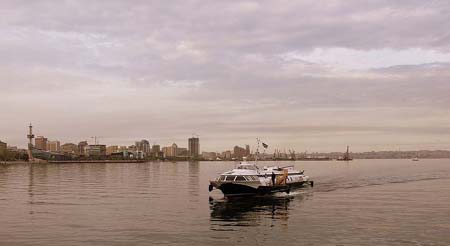
A hydrofoil at Baki, 2010 (Gulustan, via Wikimedia)
|
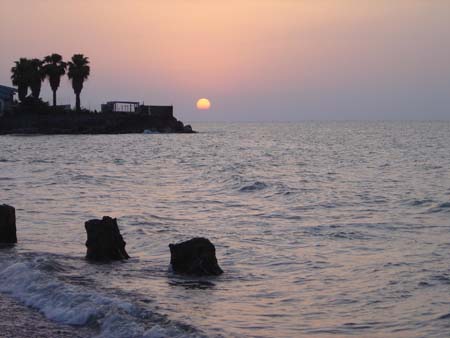
Caspian Sea, coast of Iran (Sabori, via Wikimedia)
|
|